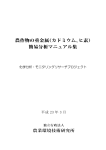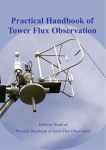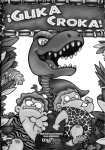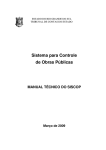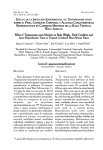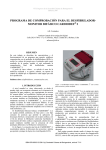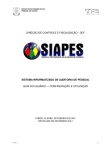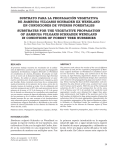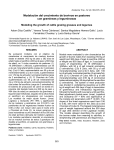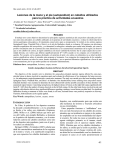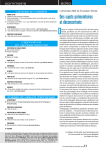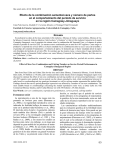Download Full article (PDF — 198.92 Kb)
Transcript
227 Cuban Journal of Agricultural Science, Volume 48, Number 3, 2014. Growth curves of developing Siboney females from Cuba, up to 18 months old Á.C. Alonso1, Bertha Chongo2, A. Zamora2, Verena Torres2, Aida C. Noda2 and F. Acosta1 Dirección Técnica Desarrollo, Empresa Pecuaria Genética “Camilo Cienfuegos” Instituto de Ciencia Animal, Apartado Postal 24, San José de Las Lajas, Mayabeque Email: [email protected] 1 2 Growth curves of 1,338 developing Siboney females from Cuba, between 0 and 18 months old, were modeled, in the period 2007-2009, with weights recorded at 0, 4, 8, 12 and 18 months. Curves were divided according to birth season, into rainy and dry seasons. Database was obtained from the information registered in SISCOP software for the studied years. Seven variants of regression models were tested (linear, square linear, cubic linear, square logarithmic, logistic, Gompertz and Richards), for data analysis, and daily weight gains were estimated through the method of square minimums. As statistical criteria for selecting the best adjusted model, the determination coefficient (R2), parameters of models(α, β, γ, δ), mean square of error (MSE), standard error of models (E(α), E(β), E(γ)), E(δ)), model signification and residue analysis were determined. For females born during rainy season, the R2 ranged between 0.94 and 0.97, while those born during dry season, the (R2) ranged between 0.95 and 0.98. It can be concluded that the best adjusted model was the square logarithmic model, with con R2 = 0.98 (born during dry season) and 0.96 (rainy season), with P < 0.001 in every case. The best increases were registered in animals born during dry season and between years. The best performance was registered in 2007 Key words: mathematic models, growth curves, liveweight, bovines Cattle production is vital for sustenance and food safety of population, so that it can cover the requirements of 91 g of daily proteins per capita (González 2009), according to the gradual demand of animal origin products, needed by the country. This demand could be reached from efficient livestock production –under efficient and profitable bases- (Benítez et al. 2009). Statistics informed from 2005 to 2010 show a sustained annual growth of milk production in Cuba (MINAG 2011). The Siboney breed from Cuba (5/8 H - 3/8 C) is one of the breeds used for these purposes because it has a wide distribution in the island, with 43.6 % of the total dairy cattle (Genética Nacional 2011), acceptable figures regarding the growth rates, besides an early incorporation with good levels of prolificacy (López 1983, López et al. 1986 and Gregorich 1992). The developing cattle is a continuity guarantee for keeping these productive increases. Predicting and describing growth curves in bovines helps to characterize production systems and animal breeds. At the same time, it allows to provide useful information for developing selection strategies (Ramírez 2007). Duarte (1975), Elías (1998), Oliveira (2000) and Abreu et al. (2004) in South America, and Perotto et al. (1997) and Mazzini (2001) in Europe have worked on modeling growth of different breeds. In Cuba, studies like those of Fernández (2004), focused on lactancy curve modeling, and researches from Alonso (2009) in female bovines, up to 18 months old, have allowed to describe some factors that compromise the current performance of this breed in formation. This study had the objective of estimating growth curves up to 18 months of age in Siboney females from Cuba, starting with the control weighing carried out at birth, at 4, 8, 12, and 18 months old, with the application of linear and non linear regression models, for 2007-2009. Materials and Methods A total of 1,338 records of females born between 2007 and 2009, from Siboney breed of Cuba were used in the U.E.B “Loma de Candelaria”, belonging to the Empresa Pecuaria Genética “Camilo Cienfuegos”. These records were obtained from a weighing gathered in the SISCOP program (Caunedo 1992) during the 0, 4, 8, 12 and 18 months. The data extracted from the PVV. sgh, where all the weighings are located within the SISCOP databases, were organized per each year in Microsoft Excel. As a criterion for the statistical analysis per year, females were divided according to the season of their birth: 784 calves in dry season (from November 1st to May 14th) and 554 in rainy season (from May 15th to October 31st). For analyzing and processing obtained data, four models of linear regression and three non linear regression models were tested. According to Ratkowsky (1983), these models are the most used for estimating animal behavior: Linear models: Linear: y = alfa + beta (age) Square linear: y = alfa + beta (age ) + gamma (age )2 Cubic linear: y = alfa + beta (age ) + gamma (age )2 + delta (age )3 Square logarithm: Log y = alfa + beta (age) + gamma (age )2 Non-linear Logistic: y= alfa 1 + beta. exp[− gamma.((age edad)])] 228 *** 0.0029 0.97 *** 305.85 -0.004 -0.003 ns 0.95 *** 306.11 0.95 -0.03 0.01 *** -0.15 0.08 * -0.0026 0.00004 *** MSE 306.68 R2 0.95 Sign *** *** *** *** 281.47 281.06 0.03 α β 35.5 12.54 0.74 0.07 *** *** 34.43 13.0 0.92 0.24 *** *** 33.9 13.79 0.98 0.57 *** *** 1.56 0.09 0.0028 0.0007 *** *** Rainy season N=183 γ δ MSE 292.19 Out of the evaluated models (linear, square linear, cubic linear, square logarithmic, logistic, Gompertz and Richards), those of non linear regression were rejected because they did not present a significant adjustment to LW. Table 1, 2 and 3 show the results of the linear regression analysis for each season during 2007-2009. For a higher precision of the appropriate model in this type of study, an analysis of the exactitude along with the LW was made in each evaluated season per years, between 2007 and 2009. When comparing the performance models of LW between seasons, during 2007, 2008 and 2009 (tables 1, 2, and 3), it was confirmed that all of them had a very good adjustment due to their flexibility (Arias et al. 2010), with similar and high determination coefficients (R2), which indicates a good precision in the estimates. Besides, the use of linear models for describing growth of females from this breed was positive. All models differed (P < 0.001) in both seasons. Values of R2 were the best adjusted data, with 0.97, in the square logarithm for both seasons of 2007 Models estimating LW for females born in both studied seasons of 2008 differed at P < 0.001. There were low determination coefficients (0.94) in the linear and square linear adjustments, and during the rainy season. As in 2007, the square logarithmic model of both seasons in which females were born was the best adjusted, with R2 equals 0.96 during dry season and 0.97 during rainy season. The same was confirmed in 2009 (P < 0.001) in the models evaluated for both seasons (table 3). For the females born during rainy season, the R2 were lower, Table 1. Results of model adjustment for each season of female birth, 2007 Dry season Model N= 313 Parameters α β γ δ R2 Linear 38.13 11.61 0.95 SE (±) 0.95 0.09 Parameter sign. *** *** Square linear 34.13 13.34 -0.09 0.95 SE (±) 1.15 0.31 0.02 Parameter sign. *** *** *** Cubic linear 33.49 13.34 -0.26 0.01 0.95 SE (±) 1.23 0.73 0.11 -0.004 Parameter sign. *** *** * ns Square logarithmic 1.554 0.094 -0.003 0.97 SE (±) 0.003 0.001 0.00004 Parameter sign. *** *** *** * P < 0.05 ***P < 0.001 Results and Discussion Sign *** Cuban Journal of Agricultural Science, Volume 48, Number 3, 2014 Gompertz: y = alfa. exp <-beta. exp [-gamma(edad)]> Richards: y = <alfa.[1+beta. exp(-gamma.{edad})]> where: y: LW or DWG age: age of the animal alfa (α), beta (β), gamma (γ) and delta (δ): parameters Estimations for the parameters were determined by using the method of square minimums in the case of linear regression and by the iterative method of Marquardt (1963), for the non linear models (Logistic, Gompertz and Richards). The statistical criteria for selecting better adjusted models were made according to indicators described by Guerra et al. (2002 and 2003) and Fernández (2004): 1. Determination Coefficient (R2) 2. Parameters of models (α, β, γ, δ) 3. Mean square of error (MSE), 4. Standard error of model parameters SE(α), SE(β), SE(γ), SE(δ) 5. Model signification 6. Residue analysis Compiled information was processed by the statistical package SPSS version 11.5.1 (2002). Table 3. Results of model adjustment for each season of female birth, 2009 Dry season Model N= 260 Parameters α β γ δ R2 Linear 36.61 11.84 0.96 SE (±) 0.85 0.08 Parameter sign. *** *** Square linear 31.23 14.13 -0.13 0.97 SE (±) 1 0.26 0.01 Parameter sign. *** *** *** Cubic linear 32.82 11.74 0.25 -0.01 0.97 SE (±) 1.05 0.62 0.09 0.033 Parameter sign. *** *** ** *** Square logarithmic 1.53 0.1 -0.002 0.98 SE (±) 0.0033 0.0008 0.00004 Parameter sign. *** *** *** ** P < 0.01; *** P < 0.001 Table 2. Results of model adjustment for each season of female birth, 2008 Dry season Model N= 211 Parameters α β γ δ R2 Linear 31.54 11.58 0.95 SE (±) 0.91 0.09 Parameter sign. *** *** Square linear 32.91 10.99 0.03 0.95 SE (±) 1.12 0.09 0.02 Parameter sign. *** *** * Cubic linear 32.5 11.61 -0.06 0.003 0.95 SE (±) 1.2 0.7 0.1 0.003 Parameter sign. *** *** ns ns Square logarithmic 1.53 0.09 0.002 0.96 SE (±) 0.003 0.001 0.00005 Parameter sign. *** *** *** * P < 0.05 ***P < 0.001 *** 303.1 *** 185.79 *** *** 268.92 0.0021 Sign *** CMe 209.02 *** *** 303.1 0.003 Sign *** CMe 304.1 β 11.06 0.08 *** 13.04 0.27 *** 13.09 0.66 *** 0.09 0.0008 *** α β 33.29 12.39 0.94 0.09 *** *** 32.24 12.83 1.17 0.31 *** *** 30.47 15.5 1.24 0.73 *** *** 1.53 0.1 0.0037 0.0009 *** *** α 37.1 0.87 *** 32.38 1.05 *** 32.34 1.12 *** 1.54 0.003 *** 0.0003 0.003 ns -0.02 0.02 ns -0.44 0.1 *** -0.0027 0.00005 *** 0.02 0.003 *** Rainy season N=165 γ δ -0.11 0.01 *** -0.12 0.09 ns -0.002 0.00004 *** Rainy season N=206 γ δ 0.96 0.94 0.94 R2 0.94 0.97 0.95 0.94 R2 0.94 0.0042 407.68 412.49 CMe 412.9 0.0027 267.17 268.92 CMe 283.17 *** *** *** Sign *** *** *** *** Sign *** Cuban Journal of Agricultural Science, Volume 48, Number 3, 2014. 229 230 with 0.94 in all linear models, except in the square logarithmic model. As in the previous years, the square logarithmic model, for both seasons of the year, had the best adjustment, with values of R2 equals 0.98, in dry season, and 0.96 in rainy season. According to Fitzhungh and Taylor (1971), selecting a specific model for describing growth will depend on its ability for biological interpretation and on the data adjustments and its requirements, regarding a computer program. Although during all the studied years the linear models had good adjustment of R2 and P < 0.001, it is evident that the square logarithmic model was the best adjusted for LW of Siboney females from Cuba, from 2007 to 2009. The highest determination coefficients were found in this model, for all the years and seasons in which females were born, with a performance of R2 ≥ 0.96, mainly in 2007, for both seasons. These coefficients coincide with those informed by Brody (1945), cited by Fernández (1996), Molina et al. (1992) and Robert-Granié et al. (2002) in bovine growth curves. These authors consider that animal growth has a stage of linear growth. However, the adjustment of this model differs with the informed by Abreu et al. (2004), PeredaSolís et al. (2005), Agudelo et al. (2007), Malhado et al. (2008) and Alonso (2009), who found a better adjustment in non linear models during the growth-development stage, with R2 ≥ 0.90. The previous data suggests further studies on the estimation of growth curves in this breed, with the use of other models. For selecting the best adjusted model, the MSE is another statistical criterion to be considered. The square logarithmic model, for all years and seasons, had the lowest values, between 0.0021 and 0.03, inferior to those informed for the others. This allowed estimating, with higher precision, the effects of studied factors and, at the same time, selecting the best adjusted model for the analyzed cases. The lowest values of MSE were registered in the group of animals born during rainy season, with 0.0029 and 0.0027, in 2007 and 2008, respectively. This indicates that there was a lower variance of liveweight, as the described by Freitas (2005), which explains the variability of this model in all years for this season of birth. In addition, it can be considered, likewise, an expression of the use of feeding systems according to each growth stage and of the use of sustainable alternatives in livestock production, using a proper management of the grazing system during the ages in which the bovine is more efficient for pasture intake (Senra 2005 and Mejías 2008). After adjusting the model, residues of the square logarithmic model were calculated. They were obtained from the comparison between LW observed and LW calculated using the selected model, for determining the existence of underestimation Cuban Journal of Agricultural Science, Volume 48, Number 3, 2014 or overestimation of bovine LW (Fabens 1965). Regarding the criteria for the precision analysis of the estimations (residue analysis), figure 1a and b show the graphic performance of residues. Variation range of residues was between -0.1 and 0.1. The extreme values mostly corresponded to 2009, for those born during rainy season (-0.2 a 0.2). Figure 1 is essential to know the general performance of residues, according to Torres et al. (2012). The best performance was shown by 2007. Female calves born in the dry season had the highest amount of residues, closed to -0.1 and 0.1. For all the evaluated models, the α parameter indicates estimation of weight gain value reached by the animal (or the studied population), without being, necessarily, the highest weight the animal can reach, but the mean weight it gets when arriving to maturity, apart from the seasonal variations (Brown and bandermer 1997, Abreu et al. 2004 and Agudelo et al. 2007). The analysis of α parameter, obtained through the square logarithmic model, shows that the highest value ranged between 1.55 and 1.56 (P < 0.001) for both seasons, every year. This is an indicator of development for achieving a bovine asymptotic weight. When comparing the estimations obtained from the four models, the highest value was achieved by the linear model and the females born in dry season (38.13 kg). The lowest value corresponded to the square logarithmic model (1.53 kg) in both seasons of 2009. Similar results were achieved by Oliveira et al. (2000), but in a narrower range. For the rest of the linear models evaluated in both seasons, the values of this parameter had a similar performance, between 31.5 and 37.1 kg, in both birth seasons of the studied females. There was an underestimation in the square logarithmic model from α parameter. According to Freitas (2005) and Noguera et al. (2008), the β parameter does not have biological interpretation, but it is important for modeling the sigmoid curve from birth (t=0) to grown age (t→∞). Likewise, Abreu et al. (2004) state that this parameter is the integration factor that adjusts initial weight values, generally related to birth weight (development degree of the animal at birth for reaching the asymptotic weight). Nevertheless, its importance is considered for modeling the sigmoid curve, from birth to grown age, at 42 months old (Torres et. al 2012). Abreu et al. (2004) and Marques da Silva et al. (2004) stated that γ is another important parameter for the study. It represents the maturity rate of animals, as a function between maximum growth rate and adult weight of the animal (growth speed). Torres et al. (2012) reported that animals with high values of γ represent an early maturity regarding those animals with similar initial weight. In the estimation of this parameter, the contrary to the asymptotic weight happened, with the estimations of considered models 231 Cuban Journal of Agricultural Science, Volume 48, Number 3, 2014. ResiduesLogarítmo square logarithm dry season Residuos cuadráticoper poryears, años Época poca lluvia a 0.3 0.2 0.1 0.0 0 2 4 6 8 10 12 14 16 18 20 -0.1 -0.2 -0.3 -0.4 Edad Age (meses) (months) Residue 2008 Residuo 2008 Residue2007 2007 Residuo b Residue 2009 Residuo 2009 Residues logarithm perpor years, Residuossquare Logarítmo cuadrático añosrainy Épocaseason lluvia 0.3 0.2 0.1 0.0 0 2 4 6 8 10 12 14 16 18 20 -0.1 -0.2 -0.3 -0.4 Edad (meses) Age (months) Residue2007 2007 Residuo Residue2008 2008 Residuo Residue 2009 Residuo 2009 Figure 1a and b. Residue analysis of the square logarithmic model for the seasons studied between 2007 and 2009. (-0.0027 a 0.27). Oliveira et al. (2000) informed similar performance in the estimations of this parameter in bovines, as well as Torres et al. (2012) inform it for crossbred Bufalypsos. The square logarithmic model had, out of the four models, the best adjustment values of γ parameter, in both seasons and for all years, because its values (-0.0027- 0.002 and P < 0.001) and (-0.0026 – 0.002 and P < 0.001) in both seasons, respectively, were the lowest values compared to the rest of the models. This indicates a good precision of variations in the relative growth speed during both birth seasons. Besides, it also suggests stability in the growth rhythm, related to the favoring of mean daily gains of liveweight Marques da Silva et al. (2004), Malhado et al. (2008) and Torres et al. (2012) reported similar results but for non linear models adjusted to animal growth. When analyzing results of mean performance among values of LW and the LW estimated using the square logarithmic model for each studied season from 2007 to 2009 in figure 1 a and b, there was a similar performance in the curve adjustment for each year and season, with a better increase in females born in dry season and in 2007, which confirms the correct selection of the model. Similar results when modeling growth were informed by Guerra et al. (1993), Fernández (1996), Del Valle (2000) and Guerra et al. (2003), who consider the good adjustment of linear models for expressing the standard growth curve of any living organism. There are no reports of studies, in the consulted literature, in which the square logarithmic model has the best adjustment for explaining the growth curve of developing bovine female. According to Torres and Ortiz (2005), modeling and simulating can be applied to many problems related to ruminants, especially to the most studied category: milking cow. This study refers to the use of different models for describing a very important stage of bovine female, related to the increase of milk productions. According to Sampaio et al. (2005), using the better adjusted model, stochastic approximations can be made, which provide higher 232 Cuban Journal of Agricultural Science, Volume 48, Number 3, 2014 LW, dry PV Época pocoseason lluviosaper por years años a Log LW 2007 =1.554 + 0.094(t) + (-0.003) (t)2 R2 =0.97 *** Log LW 2008 = 1.53 + 0.09 (t) + (-0.002) (t)2 R2 =0.96 *** Log LW 2009 = 1.53 + 0.1 (t) + (-0.002) (t)2 R2 =0.98 *** 3.0 2.5 PV 2.0 1.5 1.0 0.5 0.0 0 2 4 6 8 10 12 14 16 18 20 Age Edad PV 2007 LW Estimated 2007 PV Estima 2007 LW PV 2008 LW Estimated 2008 LW PV Estima 2008 LW PV 2009 Estimated 2009 LW PV Estima 2009 b LW, rainy season per por years PV Época lluviosa años Log LW 2007 = 1.56 + 0.09(t) + (-0.0026) (t)2 Log LW 2008 = 1.54 + 0.09 (t) + (-0.002) (t)2 Log LW 2009 = 1.53 + 0.1 (t) + (-0.0027) (t)2 3.0 R2 =0.97 *** R2 =0.97 *** R2 =0.96 *** 2.5 PV 2.0 1.5 1.0 0.5 0.0 0 2 4 6 8 Edad 10 Age PV 2007 LW PV 2008 LW LW PV 2009 12 14 16 18 20 Estimated LW PV Estima 20072007 Estimated LW PV Estima 20082008 Estimated LW PV Estima 20092009 Figure 2 a and b. Performance of LW (kg) and mean LW, estimated through the square logarithmic model, per seasons and years, 2007-2009 information safety, and besides modeling parameters, they improve estimation levels. Similar arguments were informed by Fernández et al. (2001), Fundora et al. (2006) and Ramírez (2007). It can be concluded that, among the studied models, the linear models showed a better adjustment for describing growth from 0 to 18, for Siboney breed from Cuba, in the Empresa Pecuaria “Camilo Cienfuegos”. The square logarithmic model was highlighted, with R2 = 0.96 and high signification, in the model and in α, β, γ, δ parameters evaluated. The best increases were registered in animals born during dry season. The best performance, among the years, was in 2007. Acknowledgements Thanks to the Empresa Pecuaria Genética “Camilo Cienfuegos”, and its department of genetics, for allowing the access to their databases, and to the Department of Biomathematics from the Institute of Animal Science for their help in data processing. References Abreu, U. G., Cobuci, J. A., da Silva, M. V. G. B. & Sereno, J. R. B. 2004. Uso de modelos no lineales para el ajuste de la curva de crecimiento de bovinos Pantaneiros. Archivos de Zootecnia. Año/vol. 53. Número 204. Universidad de Cordova. España. Agudelo, D. A., Ceron, M. F. & Restrepo, L. F. 2007. Modelación de funciones de crecimiento aplicadas a la producción animal. Informe Ocasional no 18. pdf. Available on: http://www.mundoveterinario.net/nueva/ referencias/bovinos [Consulted: September 10th, 2007] Alonso, A. C. 2009. Comportamiento de las ganancias en peso vivo (de 0 a 18 meses de edad) del genotipo Siboney de la EGPCC durante cuatro años consecutivos. Master Cuban Journal of Agricultural Science, Volume 48, Number 3, 2014. Thesis. Instituto de Ciencia Animal. La Habana. Cuba Arias, Y., González-Peña, D., Montes, I. & Domínguez, A. 2010. Estimación de la curva de crecimiento en futuros sementales de la raza buffalypso. Rev. Ciencia y Tecnología Ganadera. 4: 136 Benítez, D., Ricardo, Y., Viamonte, M. I., Romero, A., Guevara, O., Verena, T. Miranda, M., Guerra, J. & Olivera, C. 2009. Technological alternatives for replacement cows in the Cauto Valley. Cuban J. Agric. Sci. 43:351 Brown, W. & Bandermer, H. 1997 Aplicaciones de las técnicas de simulación matemática. NIAES. Series No. 3: 173-188 Caunedo, J. 1992. Software SISCOP. Empresa Pecuaria Genética “Niña Bonita”. Cuba Del Valle, J. 2000. La multicolinealidad en modelos de regresión lineal múltiple. Master Thesis. Universidad Agraria de La Habana, Cuba Duarte, F.A.M. 1975. Estudo da curva de crescimento de animais da raça Nelore (Bos taurus indicus) através de cinco modelos estocásticos. 284 f. Tese (Livre-Docência) - Faculdade de Medicina de Ribeirão Preto, Universidade de São perior de Agricultura de “Luiz de Queiroz”, Piracicaba. Elías, M.A. 1998. Análise de curvas de crescimento de vacas das raças Nelore, Guzerá e Gir. 128 f. Dissertação (Mestrado em Zootecnia) - Escola Su Fabens, A. J. 1965. Properties and fitting of the von Bertalanffy growth curve. Growth 29: 265 Fernández, L. 1996. Modelos que describen la dinámica de los procesos biológicos en las ciencias. Tesis de Maestría. Universidad Agraria de La Habana, Cuba Fernández, L. 2004. Modelos estadísticos-matemáticos en el análisis de la curva de lactancia y factores que la afectan en el genotipo Siboney de Cuba. PhD Thesis. 113 pp. Fernández, L., Menéndez, A., Guerra, V., & Suárez, M. 2001. Estimation of the standard lactation curves of the Siboney de Cuba breed for their use in lactation extensions. Cuban J. Agric. Sci. 35: 93. Fitzhungh, H. A. Jr. & Taylor, St. C. S. 1971. Genetics analysis of degree of maturity. J. Anim Sci 33: 717 Freitas, A.R. 2005. Curvas de crescimento na produção animal. Rev. Bras. Zoot. 34:786 Fundora, O., Torres, V., González, M. E., Noda, A. 2006. Growth curve and liveweight in a river buffalo herd. Cuban J. Agric. Sci. 40:401. Gonzáles, S. 2009. Estimación de los parámetros, valores y tendencias genéticas para los rasgos de crecimiento del ganado Cebú cubano. PhD Thesis. CIMAG. Cuba Gregorich, J. 1992. Comportamiento de la actividad estral y la fertilidad en rebaños Siboney. Trabajo de Diploma. Universidad de Granma. Bayamo, Granma, Cuba Guerra, W., Cabrera A. & Fernández, L. 2002. Propuesta metodológica para la selección de modelos estadísticos. Aplicaciones a modelos de regresión. Monography. UNAH. La Habana, Cuba. 35p. Guerra, C.W. 2003. Criteria for the selection of statistical models in scientific research Cuban J. Agric. Sci. 37:3 Guerra, W., De Calzadilla, J. & Del Valle, J. 1993. Aspectos cualitativos-cuantitativos sobre modelos que describen la dinámica de crecimiento en poblaciones. Monography. Universidad Agraria de La Habana. 13 pp. López, D. 1983. Caracterización de la población base de un nuevo genotipo lechero tropical. El Siboney de Cuba. 233 PhD Thesis. Instituto Superior de Ciencias Agropecuarias de La Habana. López, D., Ponce de León, R. & Orrel, R. 1986. Características del crecimiento y comportamiento reproductivo de novillas de primer nivel inter-se 5/8H 3/8C. Memorias ALPA 21: 12 Malhado, C.H.M., Ramos, A. A., Carneiro , P.L.S., Souza J.C., Wechsler, F.S., Eler, J.P., Azevêdo, D.M.M.R. & Sereno, J.R.B. 2008. Modelos no lineales para describir el crecimiento de bufalinos de la raza Murrah. Archivos de Zootecnia. 57: 498 Marques da Silva, N. A., Henrique de Aquino, L., Fonseca e Silva, F., Ilson Gomes de Oliveira, A. 2004.Curvas de crecimiento e influencia de factores no genéticos en las tasas de crecimiento de bovinos de la raza Nerole. Ciênc. Agrotec. Lavras. 28: 647 Marquardt, D. W. 1963. An algorithm for least square estimation of non-linear paramet. J. Soc. Indust. Appl. Math. 11: 431 Mazzini, A. R. A. 2001. Análise da curva de crescimento de machos Hereford considerando heterogeneidade de variâncias e autocorrelação dos erros. Dissertação (Mestrado)-Universidade Federal de Lavras, Lavras. 94 p. Mejías, R. A. 2008. Sistema para la producción de hembras bovinas de reposición con asociación de gramíneas con leguminosas. PhD Thesis. ICA. MINAG, 2011. Balance productivo de los rebaños lecheros en Cuba en el último quinquenio. Ciudad Habana, Cuba Molina, A., Serrano, M.I., Burgos, A., Jiménez, J.M., Salado, F. M., Cabeza de Vaca, F., Espárrago, E. & Rodero, A. 1992. Estimación de la curva de crecimiento en vacuno retinto: aspectos prácticos para la tipificación de pesos. Available on: http://dialnet.unirioja.es/servlet/ articulo279549. Consulted: February 1st, 2010 Noguera, R.R., Pereira, R.L. & Solarte, C. E. 2008. Comparación de modelos no lineales para describir curvas de crecimiento en cuyes (Cavia porcellus) desde el nacimiento hasta la edad de sacrificio. Libestock Res. Rural Devel. 20:5 Oliveira, H. N., Lôbo, R.B. & Pereira, C. S. 2000. Comparação de modelos não-lineares para descrever o crescimento de fêmeas da raça Guzerá. Pesquisa Agropecuária Brasileira, Brasília. 35: 1843 Pereda-Solís, M.E., González-Muñoz, S., Arjona-Suárez, E., Bueno-Aguilar, G. & Mendoza-Martínez, G. 2005. Ajuste de modelos de crecimiento y cálculo de requerimientos nutricionales para bovinos Brahman en Tamaulipas, México. Revista Agrociencia, 39:19 Perotto, D., Castanho, M. J. de P.; Cubas, A. C.; Rocha, J. L.; Pinto, J. M. 1997. Efeitos genéticos sobre as estimativas dos parâmetros das curvas de crescimento de fêmeas bovinas Gir, Guzerá, Holandês x Gir e Holandês x Guzerá. Revista Brasileira de Zootecnia. Viçosa. 26: 719 Ramírez, R. 2007. Modelación de curvas de crecimiento y producción de leche en ganado bovino. Artículo en pdf. Ratkowsky, D. A. 1983. Non-linear regression modeling. Mercel dekker. New York. 297 p. Robert-Granié, C., Heude, B. & Foulley, J.L. 2002. Modeling the growth curve of Maine-Anjou beef cattle using heteroskedastic random coefficients models. Genet. Sel. Evol. 34: 423 Sampaio, I., Ferreira, W & Bastos, F. 2005. Selecting high performance rabbits at early ages thought and stochastic 234 approach. J. Animal Prod. 10:81 Senra, A. 2005. Indices to monitor the efficiency and sustainability of the grassland ecosystem in cattle rearing. Cuban J. Agric. Sci. 39:13 SPSS. 2002. Software estadístico. Manual de usuario. Versión 11.5.1. EUA. Sp. Torres, V. & Ortiz, J. 2005. Application of modeling and Cuban Journal of Agricultural Science, Volume 48, Number 3, 2014 simulation to the production and feeding of farm animals. Cuban J. Agric. Sci. Volume 39. Special Number. ICA. Havana. Torres, V., Barbosa, I., Meyer, R., Noda, A. & Sarduy, L. 2012. Criteria of goodness of fit test in the selection of non-linear models for the description of biological performances. Cuban J. Agric. Sci. 46: 345 Received: April 19, 2014








